« July 2013 |
Main
| September 2013 »
 August 29, 2013 | Best of JM: Sometimes things are less than they seem.
August 29, 2013 | Best of JM: Sometimes things are less than they seem.
Enjoy the popular archive material below.
From December 10, 2009 | Numbers

The above was created by Akitaoka Akiyoshi; would you believe the lines in this picture below are completely parallel? The floor appears to bulge out, though this image consists of only squares. Look again.
For more pictures see Akiyoshi's illusion pages
In our recent December/January MandolinSessions, "Something Old. Something New." we take a look at a sequence of notes that is arguably the second most important scale/mode in jazz, eclipsed only by the Major Scale. Its incarnation in the article is called the "Augmented 11th Scale," but as you read farther, it's known by other names.
The pattern is incredible fodder for improvisation, and we hope to explain its potential in future articles here and at the Mel Bay MandolinSessions website. We actually introduced this in a very early submission (August 2004), describing its construction, and we cover some of its uses in the "Getting Into Jazz Mandolin" book. What we describe here is how similar it is to modes you already know and are probably using. Our goal is to develop drills that will make the sound of the scale a sonic entity unto itself.
What's intriguing about music theory is occasionally, you find commonalities that make the vast span of music creation shorter, rather than increasing the breadth of its complexity. In this case, we have three different scales that can be found in this one eight-note sequence, the Augmented 11th, the Altered Scale, and the ascending Melodic Minor Scale. The only difference in the patterns is the harmonic context.

What happens is when you learn this one sequence of notes, all you have to do is vary the starting note; you have the series in your fingertips. Hopefully they will be residing in your ear and brain as well.
Check out the article: Something Old. Something New.
Further:
Extending your vocabulary: The Augmented 11th
The Altered Scale: Bebop Mandology
Fingers, Ears, Brain
How do you think?
Posted by Ted at 9:43 AM
 August 22, 2013 | Best of JM: Numbers
August 22, 2013 | Best of JM: Numbers
Enjoy the popular archive material below.
From August 12, 2010 | Numbers
3. 5. 7.
If you were asked to memorize these numbers, it probably wouldn't be much of a struggle. You might be able to commit the sequence to memory just because it's short, just three digits. You might frame them in some categorical way, numerically, like "the first three odd numbers after one." It might be a hotel or dorm room you stayed at once. It might be the numbers of the months your three children were born in, March, May, July.
We think numbers in a "rote" context, and we often comprehend them as relationships.
2.4.6.
This would be another set of three numbers you might attack as "the first even numbers." You might think of the third number "6" as being the sum of the first two. Different brains will assimilate these in individual ways.
357246.
If we started with these six numbers and asked you to memorize them, you could probably do it. You might think in chunks, three hundred fifty-seven, and two hundred forty-six. You might tack on the previous relationships we already mentioned. Of course, two sets of three digit numbers is easier to assimilate than six individual ones.
0101
That's an easy one. It's only two numbers repeated, but again, what if we asked you to memorize the following sequence of notes:
3572460101
In this context, it would be tough, but if you'd learned them as 357, 246, and 0101 and put them together, with some kind of number relationship, you could do it and probably quite simply.

This strategy of stringing numbers is excellent for learning and memorizing the notes of a melody. You can think of it as relationships, pitches in a sequence from a scale. Think of them as members of a chord (or non-members). This is also the strategy of the FFcP.
Early in life, a child learns the numbers as individual identities. One is followed by two. Next comes three. At some point, the concept of tens and one-hundreds becomes cognitive, and later mathematical functions develop to higher functions, some all the way to complex geometry and calculus. Inherent in the FFcP are the basic elements of music, the scale itself, pitch relationships of the 3rds and 4ths intervals, an arpeggiated diatonic chord progression (I Maj7, vi7 , ii7, V7), and finally the pull of 4 to 3, 7 to 1, etc..
Playing these and getting them into your fingers is the way you can prepare for advanced melody and chord recognition. You don't think Bb, you think 2 of an Ab scale, you think C, D, Eb, F as the first four notes of a C minor scale, all this of course based on the context of the key you are in. The nice thing is with our FFcP Studies you are mastering the secret of the mandolin. There are only four patterns!
Of course everyone is going to be different. Some will respond aurally, some visually, some tactilely. Just like someone you know who has no problem remembering 10 digit numbers without simplifying word or numbers tricks. You need to discover what works best for you and now worry about how others learn.

Find a familiar song and see what you can do with these sort of elementary analysis. You might uncover tips on how you can learn new music faster!
Further:
Sharpening learning skills
The Inner Game of Stress
Sometimes things are less than they seem
Calisthenics and mandolins.
Fingers, Ears, Brain
Posted by Ted at 6:21 PM
 August 15, 2013 | Fresh improv; spicing up your V7 chords
August 15, 2013 | Fresh improv; spicing up your V7 chords
We're always looking for a little "flavor" when we improvise. Great improvisation doesn't just come out of nowhere, it's derived from simple mechanical tools and taken to the next level with inspiration and intuition. You know about using major and minor scales, modes and the elementary fodder that some great music can come out with some simple tricks.
You know that the major scale contains a pattern that all the modes come out of. It's just a matter of starting the major on a different note to express the pattern that we know as Dorian, Mixolydian, Lydian, and the others. You know the minor scales are based on variations of the Aeolian mode, manipulating the 6th and 7th scale degrees to create the Harmonic, Melodic, and Natural minor scales, depending on the vertical (chord) context of the music.
We've mentioned a fun scale that takes the Major scale, raises the 4th and lowers the 7th. We call it the Augmented 11th scale (the 11th is the 4th) with its implied (lowered) dominant 7th scale degree. We've also looked behind the curtain to reveal it's the same pattern of notes that you find in a Melodic minor, and Altered scale, but like the church modes, the sequence starts on different notes.
If you aren't already familiar with the Aug 11th scale, review this article:
Cool sounds with a simple new scale
We claim it's the second most important scale for a jazzer to learn, only surpassed by the Major scale. What we want to do now is introduce a way to inject this into one of the most important progressions in Western European music, the 'V7 I' cadence.
Tonic/Dominant with Aug11th
Using our FFcP approach, here are 4 different ways to finger an Aug11th scale, on four different pitches:
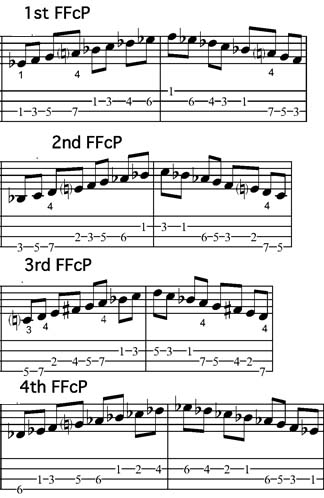
Here's your trick of the day. If you get this into your fingers, ears, and eventually brain, you'll be able to inject this into about any V7 (Dominant 7th) chord for a tasteful departure. What you want to do is start the scale 1/2 step above the tonic.
Sub Aug 11th scale 1/2 step up:

The above pattern is in the key of C, but rather than stick with the boring notes of the G7 chord, a C scale based on the chordal notes of G, B, D, F, and the passing tones of A, C, E, substitute the Aug 7th scale based on Db (1/2 step above tonic C). Theory Nerd alert: You may already be aware of Tritone subs, this variation of the Db scale gives you some important tones, the G and Cb , which is the root G, and enharmonic spelling of B natural in the key of C.
One of the dangers of playing any scale in improvisation is sounding like you're playing scales. We want to immediately suggest a simple variation of the scale to introduce some skips as you practice this.
Steppin' out: vary from scale.

Here's a PDF of an exercise you can use to expand these to the other FFcP possibilities. Download it and give it a try. We give you a 'V7 I' in the arbitrary keys of C, B, A, and D.
Download PDF  Tonic/Dominant: Aug11th FFcP Tonic/Dominant: Aug11th FFcP
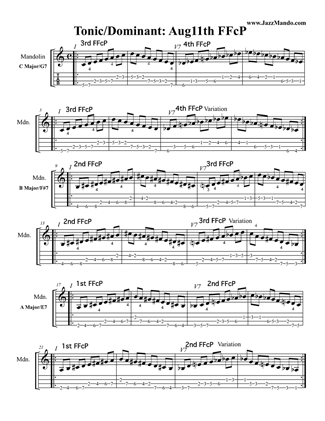
At the end of the exercise, we give you more variations of the Aug 11th FFcP you can use to journey farther than the 1st variation. Try injecting these in your practice as you familiarize your fingers and ears.
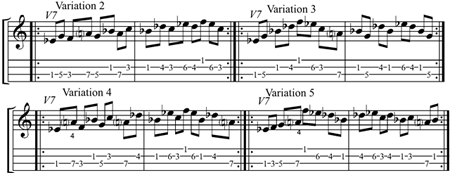
How about some accompaniment:
 'V7 I' Audio 'V7 I' Audio
Enjoy!
Further:
Cool sounds with a simple new scale
Hungry for music theory
Aug7th FFcP
New FFcP! Augmented 11th Exercises
Fresh Material for the V7 Chord; Django's Castle.
Posted by Ted at 10:53 AM
 August 8, 2013 | Scarpology. Guaranteed freshness in improvisation.
August 8, 2013 | Scarpology. Guaranteed freshness in improvisation.
Outside of the "just blow" method to improvisation, there are two practical approaches to developing soloing skills. One is to master "licks" or patterns of music you pick up listening to others. The 2nd approach is even more scientific, applying music theory by mastering scales and arpeggios.
There are advantages and disadvantages to each. Scales get you all members of the "appropriate" tones of the chord and subsequent passing tones. Learn a major or minor scale, a dorian or mixolydian mode and your on the path to creating melodies, albeit at the risk of sounding like you're playing scales. Arpeggios are great for communicating the harmonic nature of the music by literally spelling out the chords, but skipping around the fretboard leaves the listener wanting something linear. Plus, you miss the gravitational pull of the passing or preparation notes.
A mixture is always best. Learn your scales. Learn your arpeggios. Learn some licks. Our FFcP fundamental helps you with the first two, and we feel the systematic approach is a great way to transcend the mechanical and grind it into the intuitive. Play them so well that you forget them.
We've been enjoying a fresh new approach that combines some of this in a unique way , Texas musician/educator Steven Horn's "Scarpology." We're just starting to dig into this ourselves, and feel this is another one of those "leap ahead"methods of study that can open up your fretboard in ways you never dreamed. The idea is to break the scale into two octaves of arpeggios in a way that gets you thinking both chord and scale at the same time. It propels your access to harmonic fodder, and helps introduce modes and chord extensions in a revolutionary approach. It also moves you immediately into the entire real estate of the mandolin fretboard.
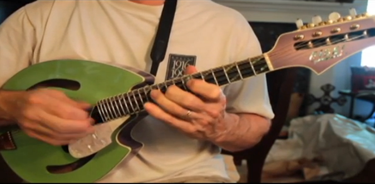
We hope to go deeper into this ourselves. Steve's website in itself is worth digging around, but we recommend you go the next step and actually purchase his book. Meantime, take some time to watch the video below, and if your curiosity is piqued, check out the next five in his introduction series.
Video Link: Scarpology
The book, Scarpology: a Mapping of the Fretboard and an Introductory Method for Improvisation on Mandolin or Other Instruments Tuned in Perfect Fifths is available in print from the author and in EBook format at Amazon Kindle Books and at Barnes and Noble Nook Books.
Link for Kindle
Link for Nook
Link to Author
Author's website: MandoSimean
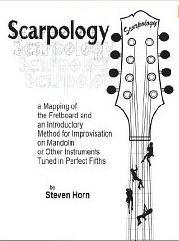
Further:
Thin-slicing and Music Theory
Building a solo
Going beyond "playing."
Don Stiernberg on the "Big Picture" of improvising
Improvisation Techniques
Posted by Ted at 7:03 AM
 August 1, 2013 | John McGann; Right hand considerations for flatpicking
August 1, 2013 | John McGann; Right hand considerations for flatpicking
We had the pleasure of knowing multi-instrumentalist/educator John McGann for most of a decade, and have always appreciated his words of wisdom in personal correspondence as well as the generous public free resources on his website, (unfortunately no longer active). We miss his insight and certainly his wit.
We've borrowed the following treatise on picks from his site for you to read, and we look forward to continue to post more gems in the future.
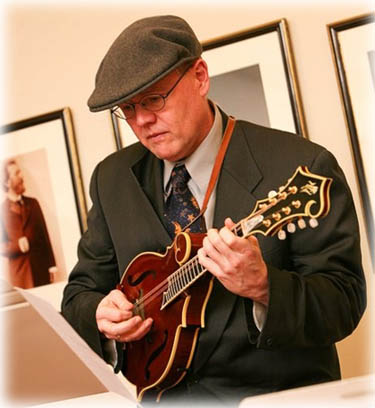
Right hand considerations for flatpicking
John McGann
The right hand makes the instrument speak, so you can consider it the source of your voice on the instrument. Wind instrument players refer to " embouchure" when discussing tone production--the way the mouth and lips fit on the mouthpiece to create their personal sound. Awareness of right hand position is crucial to achieve a great tone on your instrument.
Pick material--the choice of material and thickness of the pick has a huge effect on your tone. A medium Fender pick, played in a traditional fashion with the point, has a totally different tone than a 1.5mm Dunlop Tortex (synthetic tortoise shell) pick played on one of it's upper, beveled edges.
Explore the options of tone by trying different picks. You'll find a snappy, trebly attack from the thinner picks, and a warm, burnished tone from the thicker ones. Irish musicians tend toward the thin picks, as they like the quick snap for fast picked triplets. I DO NOT use thinner picks for Irish music, or any music for that matter. My favorite American acoustic musicians (Tony Rice, David Grisman, Sam Bush, Russ Barenberg) all use the rounded corners of their picks to get their individual, amazing sounds. Experiment with different picks until you find what you like best.
My belief is that thicker picks make acoustic instruments do what they NEED to do to project the best tone- RESONATE. The thin pick deflects off the string, and the string does not take the full energy of the pick attack. A thick pick delivers all the energy to the string, which vibrates fully, making the bridge and top resonate, creating the sound waves that bounce around in the box and pour out of the soundhole(s). With a thin pick, the string plays the pick as much as the pick plays the string!
It is my opinion the thicker picks allow you to maximize tone production and volume.
Also consider acoustics--bass frequencies travel further than highs. Thin picks do not bring out the low end of an instrument, but the brightness gives the player the illusion they are creating volume. Walk down a city street and wait for a car with "bass tubes" blasting hiphop (it won't take long!) and listen to the drive toward the hills. You hear that "thump" in the bass long after the shimmering audio detail :) in the upper freqencies is inaudible.
If you play electric, you may want a thinner pick to go with the lighter string gauges.I use the 1.5 Dunlop Tortex 500 Series Delrin on acoustic AND electric (regular .010 set). You may want to go lighter on electric; I used to use a Fender Extra Heavy but have grown to like the feel of the Dunlop on electric.
On the "Django" guitars I use a custom made 3.5mm tortise shell pick. It is a school of tone production peculiar to the "Gypsy Jazz" idiom, and certainly brings out the best tone these guitars have to offer. Gypsy Jazz Guitar is a whole 'nother world of right hand technique. Downstrokes, rest strokes and all: Check out www.djangobooks.com and Michael Horowitz' "Gypsy Picking".
Pick angle--if you hit the strings with the pick at a flat, perpendicular angle, you'll be slapping the string. I like to get a loud,warm sound by picking at a slight angle, tipping my right thumbnail toward the floor.The idea is to draw the pick through the string, much like a fiddler draws the bow across the string.
The "window of travel"--visualize a window starting on the 5th string (A). The pick can reach back to the 6th string and up to the 4th string. If you stay within that window while attacking the A string, you'll achieve economy of motion. To continue this concept to the other strings: imagine the window on each string. To deliver the pick to the string, you must have mobility. You should have your elbow relaxed enough to drop your hand down to the 1st string, and back up to the 6th string. Any kind of anchoring of your hand will limit your mobility and ability to deliver the same stroke, with maximum effect, to each string.
Remember turntables? The early ones had a pivot point, and the needle would be at a much sharper angle on the last song of the LP than the 1st. Then, the "linear tracking tonearm" came along, that allowed the tonearm to move laterally, so the angle of the needle remained the same. Try to imaging your pick as the needle, and your "tonearm" moving to deliver the pick to each string at the same relative angle, without twisting to reach any string. It is really comfortable and easy when you get the hang of it!
The pick motion comes totally from the wrist, and the elbow moves only to deliver the pick to the string. Gravity allows you to "fall" through the string with very little effort. Picking should not be like driving a nail!
Pick motions made solely by the thumb and finger produce tiny tone and volume, because there is no support behind it.
I touch just above the "karate-chop" edge of my hand on the bridge pins (acoustic guitar) or just below the saddle (mandolin, electric guitar) and let it move as I play. I can retain a sense of where I am, without impeding motion. Many great players play "freehand" with the right hand never touching the top. The universal tip is that you should be as loose and relaxed as possible, even at maximum volume.
BALLING YOUR HAND INTO A FIST will create tension and limit mobility and the ability to generate a rainbow of tone colors. You may get a lot of volume, but the tone is sure to be brash and nasty -and if that's what you are going for, then go for it!- but good technique should not make you a one trick pony.
The fingers that aren't holding the pick should feel 'numb' and relaxed, they will curl about halfway to the palm. This allows gravity to work in your favor. Keep the 'novocained' feeling in your wrist joint as well. Tension is the enemy!
If you do make a fist, you have to expend more effort to make the pick stroke (try it!)
"Should I plant a pinky?" There are some players who do this "posting" and make it work. I don't suggest it, as I feel it can limit mobility and create tension.
Mobility--To alter the tone quality of your sound, you'll want to move your hand from just above the bridge (most bright and trebly) toward the neck (increasingly warm and dark). There is a huge range of expression available in tone color, with the pick or with bare fingers (or nails, as in classical guitar). One of the great tone colorists on the guitar is Julian Bream. Listen to any of his recordings, especially his interpretations of Bach-- it's hard to believe it's all coming from one guitar played solo.
Further:
10 Questions for John McGann
John McGann YouTube
Last Call; "Lizard Ear Chords" on Mandolinsessions.com
Just A Little Lovin; The Wayfaring Strangers
Posted by Ted at 6:49 AM

Disclaimer: In the 'Information Age' of the 21st Century,
any fool with a computer, a modem, and an idea can
become a self-professed 'expert." This site does not
come equipped with 'discernment.'
|



